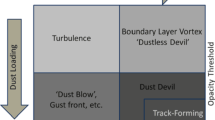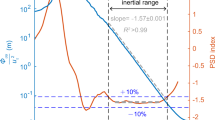Abstract
The theoretical foundations of the exponential and power-law analytical formulations for the size–frequency and intensity–frequency distributions of the convective vortices, including dust devils, are re-examined. Jaynes’ general statistical arguments based on Shannon’s entropy maximum principle leading to an exponential distribution are supplemented by Rényi’s maximum entropy principle which is shown to lead to a power-law distribution. In both cases, a key ingredient of the theory is the a priori knowledge of a first finite moment of the distribution. Applications to statistics of convective vortices, including dust devils, on Earth and Mars are discussed. The existence of a finite expectation value of the vortex diameter related to the absolute value of the Obukhov length scale in the atmospheric boundary layer allows a quantitative explanation of a burst of convective vortex activity observed at the InSight landing site in northern autumn on Mars.




Similar content being viewed by others
Data availability
This paper explains the used theoretical methods; it uses published observational data for illustration of the obtained theoretical results.
Notes
Equation 6 has real positive solutions \(\lambda_{1}\) for \({{\overline{x}} \mathord{\left/ {\vphantom {{\overline{x}} {x_{\max } < \tfrac{1}{2}}}} \right. \kern-\nulldelimiterspace} {x_{\max } < \tfrac{1}{2}}}\) where the upper limit value \({{\overline{x}} \mathord{\left/ {\vphantom {{\overline{x}} {x_{\max } = \tfrac{1}{2}}}} \right. \kern-\nulldelimiterspace} {x_{\max } = \tfrac{1}{2}}}\) corresponds to the uniform distribution \(p\left( x \right) = x_{\max }^{ - 1}\) in the interval \(\left[ {0,x_{\max } } \right]\).
Similar arguments, not detailed here, concern Rényi entropy maximization (see below), if infinity is replaced by \(x_{\max }\) in (2), (3), and (7) in the upper limit of integration. In particular, an estimate for the Insight convective vortices shows that such a replacement leads to a relative error of about 0.05%, and for the power-law distribution (with \(m = 6\)) of the Spirit dust devils is about 0.15% (see Sect. 3).
A slight difference between the number of pressure drops in Table 1 and in the text is explained by the fact that when using a catalogue of pressure drops presented as supplementary material in Spiga et al. (2021), we calculated the number of vortices with a pressure drop strictly above the given value \(\Delta P\), which coincides with the definition of CCDF, while Spiga et al. (2021) apparently calculated the number of vortices with pressure drops greater than or equal to \(\Delta P\).
This goodness-of-fit is supported by the following simple, but quite convincing argument. Using the exponential fit, we estimate the median value \(M\) of the diameter \(x \equiv D\) for the population of Spirit dust devils (Greeley et al. 2006) from the equation \(Pr \left( { > M} \right) \equiv \exp \left( { - {M \mathord{\left/ {\vphantom {M {\overline{x}}}} \right. \kern-\nulldelimiterspace} {\overline{x}}}} \right) = {1 \mathord{\left/ {\vphantom {1 2}} \right. \kern-\nulldelimiterspace} 2}\). It gives \(M \approx 27.97\,{\text{m}}{\kern 1pt} {\kern 1pt} {\kern 1pt} \times {\kern 1pt} {\kern 1pt} \ln 2 \approx 19.39\,{\text{m}}\), which is quite close to the median diameter value of \(19\,{\text{m}}\) for Spirit dust devils analysed in Greeley et al. (2006) (D. Waller, personal communication).
In these arguments, the exact value of the multiplier \(\gamma\) in the relation \(\overline{D} = \gamma \left| L \right|\) is not important because \(\gamma\) cancels out in (23).
References
Balme M, Greeley R (2006) Dust devils on Earth and Mars. Rev Geophys 44:RG3003
Carroll JJ, Ryan JA (1970) Atmospheric vorticity and dust devil rotation. J Geophys Res 75:5179–5184
Chatain A, Spiga A, Banfield D, Forget F, Murdoch N (2021) Seasonal variability of the daytime and nighttime atmospheric turbulence experienced by InSight on Mars. Geophys Res Lett 48(22):GL095453
Ellehoj MD, Gunnlaugsson HP, Taylor PA, Kahanpää H, Bean KM, Cantor BA, Gheynani BT, Drube L, Fisher D, Harri A-M, Holstein-Rathlou C, Lemmon MT, Madsen MB, Malin MC, Polkko J, Smith PH, Tamppari LK, Weng W, Whiteway J (2010) Convective vortices and dust devils at the Phoenix Mars mission landing site. J Geophys Res 115:E00E16
Fenton LK, Lorenz R (2015) Dust devil height and spacing with relation to the martian planetary boundary layer thickness. Icarus 260:246–262
Fernando B, Wójcicka N, Maguire R, Stähler SC, Stott AE, Ceylan S, Charalambous C, Clinton J, Collins GS, Dahmen N, Froment M, Golombek M, Horleston A, Karatekin O, Kawamura T, Larmat C, Nissen-Meyer T, Patel MR, Plasman M, Posiolova L, Rolland L, Spiga A, Teanby NA, Zenhäusern G, Giardini D, Lognonné P, Banerdt B, Daubar IJ (2022) Seismic constraints from a Mars impact experiment using InSight and Perseverance. Nature Astronomy 6:59–64
Greeley R, Whelley PL, Arvidson RE, Cabrol NA, Foley DJ, Franklin BJ, Geissler PG, Golombek MP, Kuzmin RO, Landis GA, Lemmon MT, Neakrase LDV, Squyres SW, Thompson SD (2006) Active dust devils in Gusev crater, Mars: observations from the Mars exploration rover spirit. J Geophys Res 111:E12S09
Greeley R, Waller DA, Cabrol NA, Landis GA, Lemmon MT, Neakrase LDV, Pendleton Hoffer M, Thompson SD, Whelley PL (2010) Gusev Crater, Mars: observations of three dust devil seasons. J Geophys Res 115:E00F02
Hess GD, Spillane KT (1990) Characteristics of dust devils in Australia. J Appl Meteorol 29:498–507
Jackson B, Lorenz R, Davis K (2018) A framework for relating the structures and recovery statistics in pressure time-series surveys for dust devils. Icarus 299:166–174
Jackson B, Crevier J, Szurgot M, Battin R, Perrin C, Rodriguez S (2021) Inferring vortex and dust devil statistics from InSight. Planet Sci J 2(5):206
Jaynes ET (1957) Information theory and statistical mechanics. Phys Rev 106:620–630
Kahanpää H, Newman C, Moores J, Zorzano M-P, Martín-Torres J, Navarro S, Lepinette A, Cantor B, Lemmon MT, Valentín-Serrano P, Ullán A, Schmidt W (2016) Convective vortices and dust devils at the MSL landing site: annual variability. J Geophys Res Planets 121(8):1514–1549
Kahre MA, Murphy JR, Haberle RM (2006) Modeling the Martian dust cycle and surface dust reservoirs with the NASA Ames general circulation model. J Geophys Res 111:E06008
Kanak KM, Lilly DK, Snow JT (2000) The formation of vertical vortices in the convective boundary layer. Q J R Meteorol Soc 126:2789–2810
Kenda B, Lognonné P, Spiga A, Kawamura T, Kedar S, Banerdt WB, Lorenz R, Banfield D, Golombek M (2017) Modeling of ground deformation and shallow surface waves generated by Martian dust devils and perspectives for near-surface structure inversion. Space Sci Rev 211:501–524
Klose M, Jemmett-Smith BC, Kahanpää H, Kahre M, Knippertz P, Lemmon MT, Lewis SR, Lorenz RD, Neakrase LDV, Newman C, Patel MR, Reiss D, Spiga A, Whelley PL (2016) Dust devil sediment transport: from lab to field to global impact. Space Sci Rev 203:377–426
Kurgansky MV (2006a) Size distribution of dust devils in the atmosphere. Izv Atmos Ocean Phys 42(3):319–325
Kurgansky MV (2006b) Steady-state properties and statistical distribution of atmospheric dust devils. Geophys Res Lett 33:L19S06
Kurgansky MV (2012) Statistical distribution of atmospheric dust devils. Icarus 219:556–560
Kurgansky MV (2019) On the statistical distribution of pressure drops in convective vortices: applications to Martian dust devils. Icarus 317:209–214
Kurgansky MV (2021) An estimate of convective vortex activity at the InSight landing site on Mars. Icarus 358:114200
Kurgansky MV, Montecinos A, Villagran V,·Metzger SM, (2011) Micrometeorological conditions for dust-devil occurrence in the Atacama desert. Boundary-Layer Meteorol 138:285–298
Kurgansky MV, Lorenz RD, Rennó NO, Takemi T, Gu Z, Wei W (2016) Dust devil steady-state structure from a fluid dynamics perspective. Space Sci Rev 203:209–244
Lorenz R (2011) On the statistical distribution of dust devil diameters. Icarus 215:381–390
Lorenz RD (2009) Power law of dust devils on Earth and Mars. Icarus 203:683–684
Lorenz RD (2014) Vortex encounter rates with fixed barometer stations: comparison with visual dust devil counts and large-eddy simulations. J Atmos Sci 71(12):4461–4472
Lorenz RD, Lanagan PD (2014) A barometric survey of dust devil vortices on a desert playa. Boundary-Layer Meteorol 153:555–568
Lorenz RD, Kedar S, Murdoch N, Lognonné P, Kawamura T, Mimoun D, Banerdt WB (2015) Seismometer detection of dust devil vortices by ground tilt. Bull Seismol Soc Am 105(6):3015–3023
Lorenz RD, Jackson BK (2016) Dust devil populations and statistics. Space Sci Rev 203:277–297
Lorenz RD, Spiga A, Lognonné P, Plasman M, Newman CE, Charalambous C (2021) The whirlwinds of Elysium: a catalog and meteorological characteristics of “dust devil” vortices observed by InSight on Mars. Icarus 355:114119
Murphy JR, Nelli S (2002) Mars Pathfinder convective vortices: frequency of occurrence. Geophys Res Lett 29(23):2103
Newman CE, Lewis SR, Read PL, Forget F (2002) Modeling the Martian dust cycle 1. Representations of dust transport processes. J Geophys Res 107(E12):5123
Newman CE, Kahanpää H, Richardson MI, Martínez GM, Vicente-Retortillo A, Lemmon MT (2019) MarsWRF convective vortex and dust devil predictions for Gale Crater over 3 Mars years and comparison with MSL-REMS observations. J Geophys Res Planets 124(12):3442–3468
Ordonez-Etxeberria I, Huesoa R, Sánchez-Lavega A, Millour E, Forget F (2019) Meteorological pressure at Gale crater from a comparison of REMS/MSL data and MCD modelling: effect of dust storms. Icarus 317:591–609
Pathare AV, Balme MR, Metzger SM, Spiga A, Towner MC, Rennó NO, Saca F (2010) Assessing the power law hypothesis for the size–frequency distribution of terrestrial and martian dust devils. Icarus 209:851–853
Petrosyan A, Galperin B, Larsen SE, Lewis SR, Määttänen A, Read PL, Renno N, Rogberg LPHT, Savijärvi H, Siili T, Spiga A, Toigo A, Vázquez L (2011) The Martian atmospheric boundary layer. Rev Geophys 49:RG3005
Rennó NO, Ingersoll AP (1996) Natural convection as a heat engine: a theory for CAPE. J Atmos Sci 53(4):572–585
Rennó NO, Burkett ML, Larkin MP (1998) A simple thermodynamical theory for dust devils. J Atmos Sci 55:3244–3252
Rennó NO, Bluestein HB (2000) A simple theory for waterspouts. J Atmos Sci 58(8):927–932
Rényi A (1961) On measures of information and entropy Proceedings of the 4th Berkeley Symposium on Mathematics. Statistics and Probability, 1960: 547–561
Ringrose TJ, Patel MR, Towner MC, Balme M, Metzger SM, Zarnecki JC (2007) The meteorological signatures of dust devils on Mars. Planet Space Sci 55:2151–2163
Shannon CE (1948) A mathematical theory of communication. Bell Syst Tech J 27(379–423):623–656
Sinclair PC (1966) PhD Thesis University of Arizona, Tucson, USA
Sinclair PC (1969) General characteristics of dust devils. J Appl Meteorol 8:32–45
Spiga A, Murdoch N, Lorenz R, Forget F, Newman C, Rodriguez S, Pla-Garcia J, Viudez Moreiras D, Banfield D, Perrin C, Mueller NT, Millour E, Banerdt WB (2021) A study of daytime convective vortices and turbulence in the Martian planetary boundary layer based on half-a-year of InSight atmospheric measurements and large-eddy simulations. J Geophys Res Planets 126:e2020JE006511
Steakley K, Murphy J (2016) A year of convective vortex activity at Gale crater. Icarus 278:180–193
Tagliani A (2003) Maximum entropy solutions and moment problem in unbounded domains. Appl Math Lett 16:519–524
Turner J (1973) Buoyancy effects in fluids. Cambridge University Press, Cambridge, UK
Zilitinkevich SS (1987) Theoretical model for the turbulent penetrative convection. Izv Atmos Ocean Phys 23:593–610
Zilitinkevich SS (1991) Turbulent penetrative convection. Avebury Technical, Aldershot
Zubov NN (1945) Arctic ice. Glavsevmorput’ Publishing, Moscow (in Russian)
Acknowledgements
I am thankful to two anonymous reviewers whose critical review and useful suggestions contributed greatly to improvements in the content and in the style of this article. This work was supported by the Russian Science Foundation (Grant No. 18-77-10076).
Author information
Authors and Affiliations
Corresponding author
Additional information
Publisher's Note
Springer Nature remains neutral with regard to jurisdictional claims in published maps and institutional affiliations.
Rights and permissions
About this article
Cite this article
Kurgansky, M.V. Statistical Distribution of Atmospheric Dust Devils on Earth and Mars. Boundary-Layer Meteorol 184, 381–400 (2022). https://doi.org/10.1007/s10546-022-00713-w
Received:
Accepted:
Published:
Issue Date:
DOI: https://doi.org/10.1007/s10546-022-00713-w




